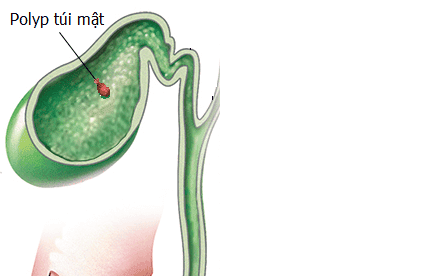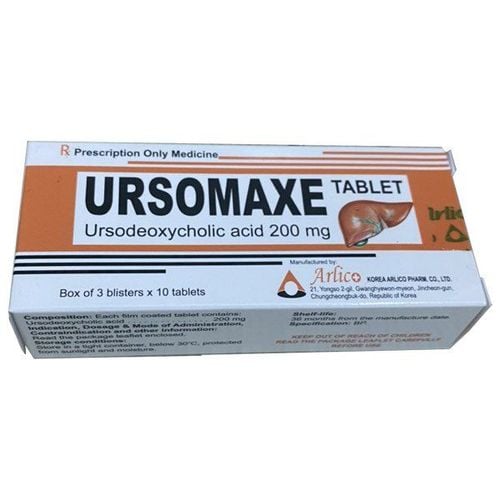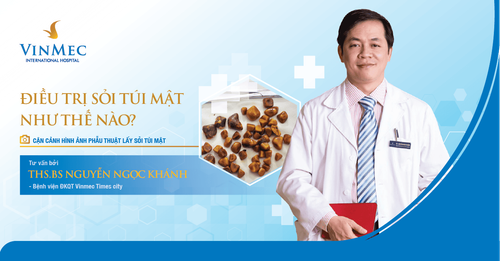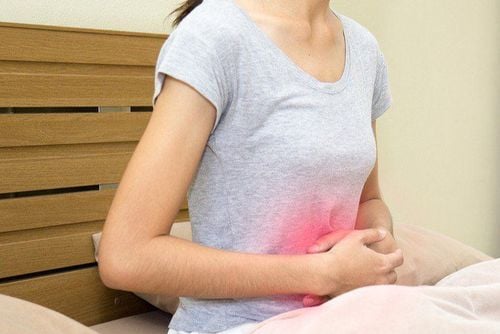This is an automatically translated article.
The article is professionally consulted by Master, Doctor Nguyen Ngoc Thang - Gastroenterologist - General Surgery Department - Vinmec Danang International General Hospital.Compared with open surgery, laparoscopic gallbladder stone treatment has many advantages, such as less invasiveness, shorter hospital stay, and faster recovery time. In particular, laparoscopic surgery will leave small scars, high aesthetics, less pain after surgery compared to open surgery methods.
1. Function of the gallbladder
The normal gallbladder is a small sac-shaped organ with a capacity of 30-60 ml, attached to the lower right lobe of the liver, and connected to the common bile duct through the cystic duct. The gallbladder is located in the right upper abdomen, just below the right costal margin. The gallbladder is responsible for concentrating and storing bile (secreted by the liver). When we eat, especially greasy food, the gallbladder will contract to push the bile contained therein into the duodenum to mix with food to help digest fat.2. What are gallstones?
Gallstones are very common in the West. The proportion of the population with gallstones increases with age. In the United States, about 25% of women and 12% of men in their 60s have gallstones. Currently, in Vietnam, with the widespread application of abdominal ultrasound in diagnosis, the rate of detected gallstones alone accounts for 58-71% of gallstones in general.Gallstones are divided into 2 main types: cholesterol stones and pigment stones:
Cholesterol stones: Made mainly from cholesterol components in bile. This type of stone is common in Western countries, accounting for 80-85%. Studies in Vietnam show that cholesterol stones only account for 30-50% of cases. This type of stone is more common in obese people, women (twice as many as men), people using a Western diet, taking estrogen birth control pills.
Pigment stones : Usually caused by biliary tract infections, hemolytic diseases, cirrhosis, inflammation or resection of the ileum (last part of the small intestine).
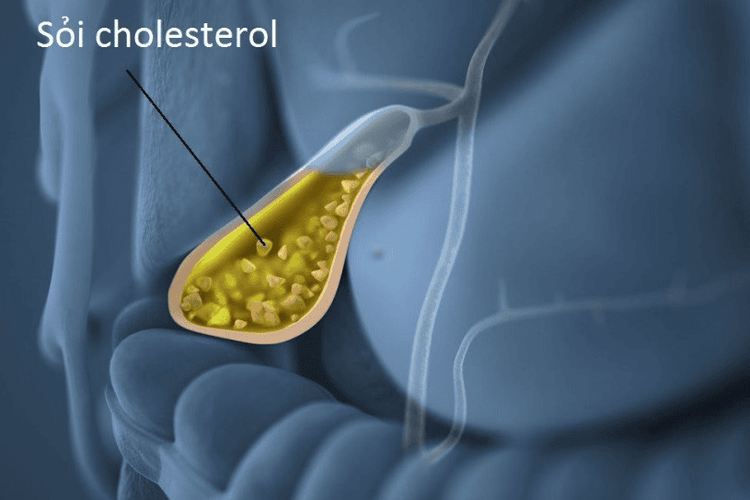
Sỏi cholesterol được tạo ra chủ yếu từ thành phần cholesterol có trong dịch mật
3. Symptoms of gallstones
About 30% of gallbladder stones are symptomatic. The most common symptom is biliary colic (86%), with the following characteristics:Cyclic: Isolated episodes of pain lasting from 30 minutes to several hours. Location: Pain occurs in the epigastrium or right upper abdomen, with most cases in the epigastrium, making it easy to mistake for peptic ulcer disease. Level: Pain is severe and continuous, the pain can make the patient stop breathing. Timing: Pain occurring within a few hours of eating, or nocturnal pain often awakens the patient. Other symptoms include back pain, left upper abdominal pain, nausea and vomiting, and bloating (indigestion with fatty foods).
4. Diagnosis of gallstones
The methods of diagnosing gallstones include:Abdominal ultrasound: Currently, abdominal ultrasound is considered the first means of diagnosing gallstones, the ability to correctly diagnose gallstones of this method is 90- 95%. Computed tomography (CT) and magnetic resonance imaging (MRI): May be used in the diagnosis of suspected gallstones that cannot be confirmed by ultrasound.
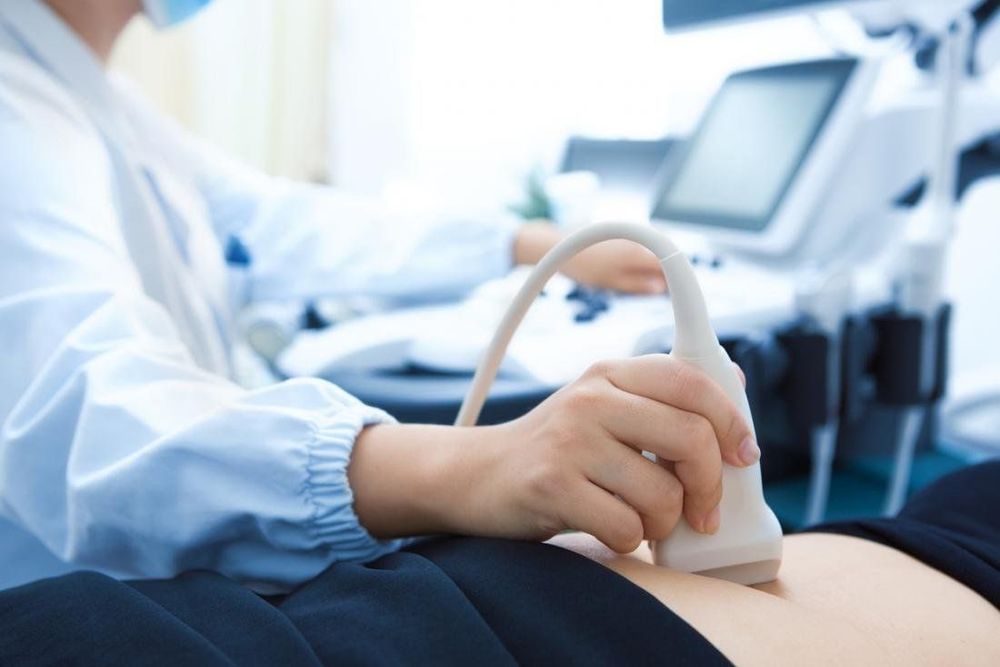
Siêu âm bụng được xem là phương tiện đầu tay để chẩn đoán sỏi túi mật
5. Laparoscopic surgery to treat gallstones
All symptomatic cases of gallstones have an indication for treatment regardless of size and number of stones. With asymptomatic gallstones, the role of cholecystectomy and other treatments is unclear. From studies that monitor the natural progression of gallstones, it is not necessary to have preventive cholecystectomy, except in cases of patients at high risk of gallbladder cancer such as porcelain gallbladder, stones associated with gallstones. Gallbladder polyps larger than 10 mm, stones larger than 25 mm...Currently, laparoscopic cholecystectomy is considered a superior method in surgical treatment of gallbladder stones. Laparoscopic surgery makes the patient more comfortable than open surgery, faster recovery time, higher aesthetics because it leaves small scars.
Laparoscopic cholecystectomy is indicated for symptomatic or complicated gallbladder stones. In addition, it is still debated about the indications for cases of gallbladder stones that have not caused symptoms and have not caused damage to the gallbladder.
After surgery, the patient still eats normally because there is still enough bile from the liver through the bile duct to go down to the intestines to help with digestion, normal work activities, unaffected sex, and no reduction in life expectancy. No need for other digestive aids.
Every year, only 1-2% of patients with asymptomatic gallstones progress to symptoms. There is some (<0.5% per year) progression from asymptomatic gallstones to the complicated phase without progressing to the symptomatic phase.
Treatment of gallstones by laparoscopic method helps shorten the patient's hospital stay, faster recovery time, less pain and high aesthetics due to small scars.
At Vinmec International General Hospital, laparoscopic cholecystectomy is currently being performed in the treatment of gallbladder dysfunction cases such as cholecystitis, gallstones, gallbladder polyps,... This technique is being used. deployed throughout Vinmec system.
Besides a team of highly qualified and experienced surgeons, Vinmec provides a full range of diagnostic and treatment endoscopic services for inpatients and outpatients. The ward is fully equipped with diagnostic endoscopy facilities, designed to meet the privacy, comfort, safety and prevention of infection through endoscopy for patients.
Master. Doctor Nguyen Ngoc Thang has 17 years of experience in the field of gastrointestinal and hepatobiliary surgery, and over 9 years of endoscopic interventional experience, especially the technique of endoscopic retrograde cholangiopancreatography. ERCP) with over 800 cases.
Please dial HOTLINE for more information or register for an appointment HERE. Download MyVinmec app to make appointments faster and to manage your bookings easily.




